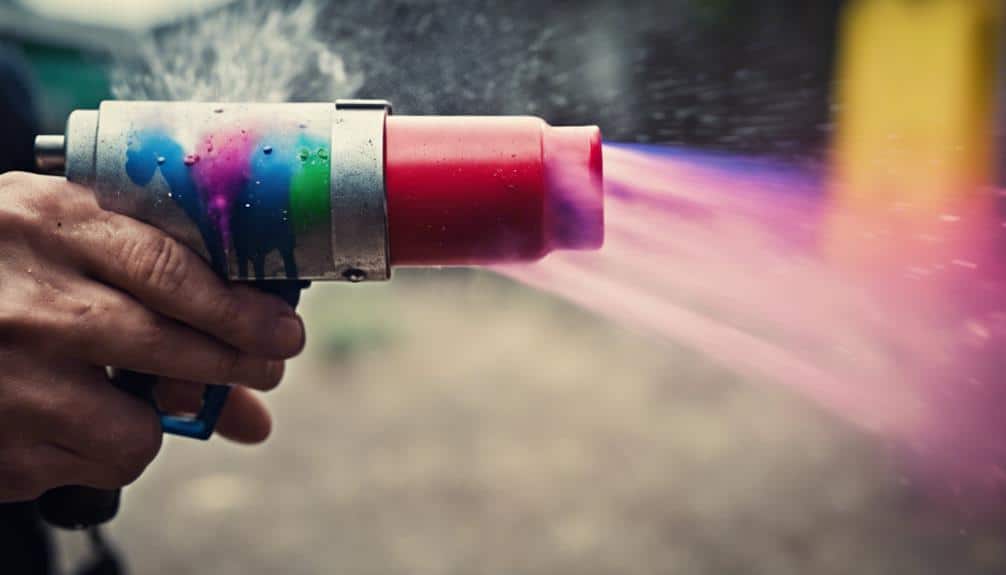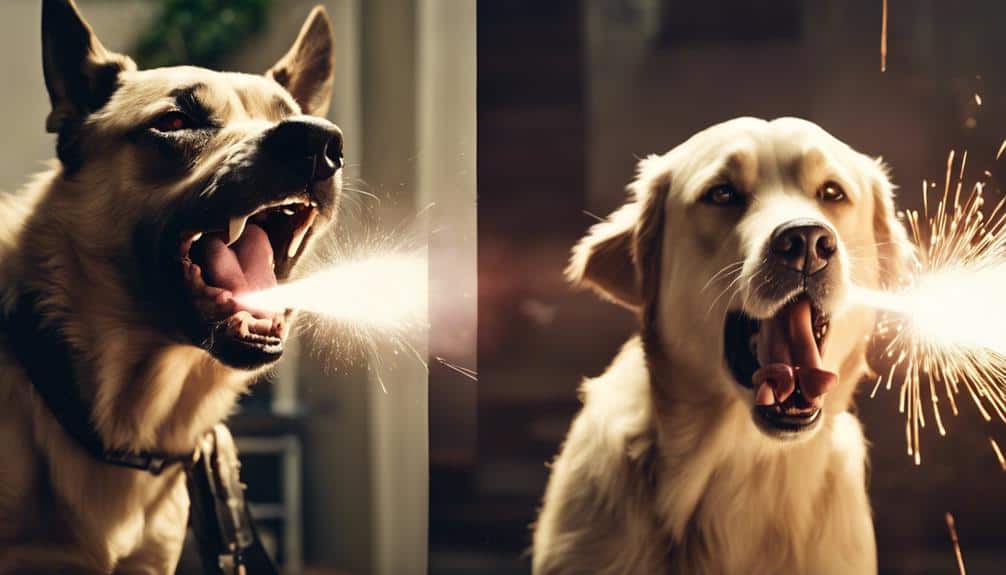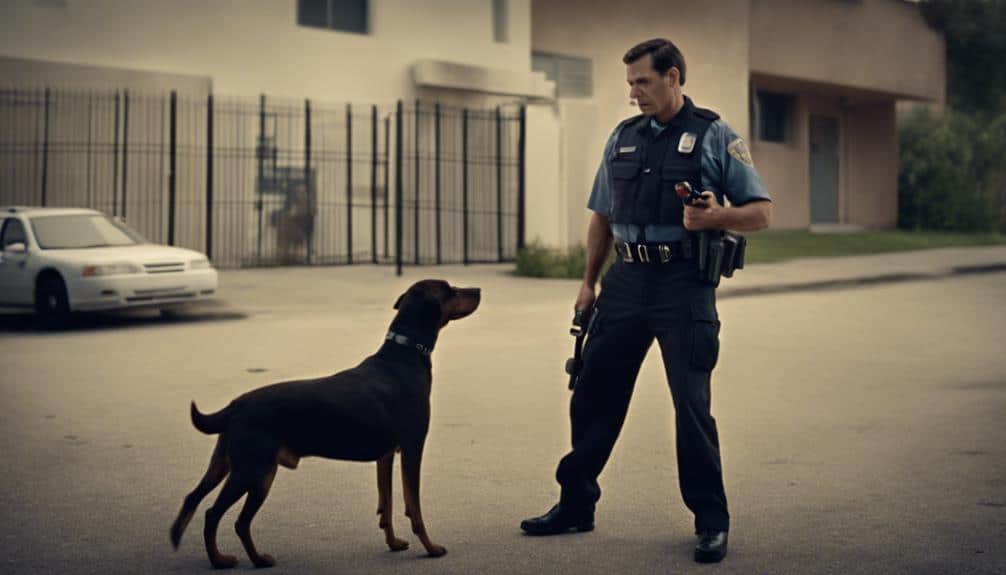Is a Stun Gun Better Than Pepper Spray for Dogs?
Let’s be real, when an aggressive dog charges at you, you’d rather keep your distance, right? Pepper spray is your buddy here, causing intense burning and temporary blindness from 8 to 12 feet away—plenty of room to stay safe! Stun guns need close contact, which, let’s face it, sounds like a terrifying wrestling match with a furry gladiator. Plus, thick fur can mess with stun gun effectiveness. Experts favor pepper spray for its ease, safety, and non-lethal effects. If you want to feel confident in handling aggressive dogs, stick around because there’s more to know.
 Pepper spray, an aerosol containing oleoresin capsicum (OC) from chili peppers, causes intense burning, temporary blindness, and difficulty breathing when it contacts a dog’s face.
It’s a powerful tool in personal defense, especially when faced with an aggressive dog. Imagine a sudden encounter with a snarling, advancing canine. Your heart races, but you’ve got a secret weapon: pepper spray. This non-lethal method is designed to protect you without causing permanent harm to the animal.
To use it effectively, aim for the dog’s face, specifically the eyes and nose. That’s where it packs the most punch, disorienting the dog long enough for you to escape. The recommended distance for deploying pepper spray is 8 to 12 feet, giving you a safe buffer between you and the threat. Just think, you don’t want to get too close to those snapping jaws!
However, don’t just grab a can and hope for the best. Practice makes perfect. Training and practice are essential to guarantee you’re ready to use it in an emergency. A bit of preparation can boost your confidence and make you feel like a true pepper spray pro, ready to handle whatever comes your way.
Pepper spray, an aerosol containing oleoresin capsicum (OC) from chili peppers, causes intense burning, temporary blindness, and difficulty breathing when it contacts a dog’s face.
It’s a powerful tool in personal defense, especially when faced with an aggressive dog. Imagine a sudden encounter with a snarling, advancing canine. Your heart races, but you’ve got a secret weapon: pepper spray. This non-lethal method is designed to protect you without causing permanent harm to the animal.
To use it effectively, aim for the dog’s face, specifically the eyes and nose. That’s where it packs the most punch, disorienting the dog long enough for you to escape. The recommended distance for deploying pepper spray is 8 to 12 feet, giving you a safe buffer between you and the threat. Just think, you don’t want to get too close to those snapping jaws!
However, don’t just grab a can and hope for the best. Practice makes perfect. Training and practice are essential to guarantee you’re ready to use it in an emergency. A bit of preparation can boost your confidence and make you feel like a true pepper spray pro, ready to handle whatever comes your way.
 Understanding the impact these self-defense tools have on dogs is essential for making an informed decision.
When it comes to pepper spray, it works by irritating a dog’s eyes and respiratory system. Imagine the poor pup suddenly overwhelmed, eyes watering, nose burning—it’s not permanent harm, but it’s definitely effective in stopping an aggressive dog in its tracks. You get a range of 8 to 12 feet, so you can keep a safe distance while protecting yourself.
On the flip side, a stun gun delivers an electric shock. It’s like a jolt of lightning that can temporarily incapacitate a dog. But here’s the catch—you need to get close. And let’s be real, getting close to an aggressive dog? Not exactly ideal. Plus, if the dog has thick fur or is wearing any kind of clothing (yes, some dogs do wear outfits), the stun gun’s effectiveness drops.
While both tools can deter an aggressive dog, pepper spray often comes out on top in self-defense scenarios. It’s recommended by experts for good reason. You can handle multiple dogs if needed, and you’ve got that vital distance keeping you safer.
Understanding the impact these self-defense tools have on dogs is essential for making an informed decision.
When it comes to pepper spray, it works by irritating a dog’s eyes and respiratory system. Imagine the poor pup suddenly overwhelmed, eyes watering, nose burning—it’s not permanent harm, but it’s definitely effective in stopping an aggressive dog in its tracks. You get a range of 8 to 12 feet, so you can keep a safe distance while protecting yourself.
On the flip side, a stun gun delivers an electric shock. It’s like a jolt of lightning that can temporarily incapacitate a dog. But here’s the catch—you need to get close. And let’s be real, getting close to an aggressive dog? Not exactly ideal. Plus, if the dog has thick fur or is wearing any kind of clothing (yes, some dogs do wear outfits), the stun gun’s effectiveness drops.
While both tools can deter an aggressive dog, pepper spray often comes out on top in self-defense scenarios. It’s recommended by experts for good reason. You can handle multiple dogs if needed, and you’ve got that vital distance keeping you safer.
 Considering safety, using a stun gun on an aggressive dog requires direct contact, which increases the risk of injury to you. Imagine having to get close enough to touch an angry dog—yikes! That’s why pepper spray might be a better choice.
Pepper spray allows you to keep a safer distance while effectively deterring the dog. Plus, it’s non-lethal, which means it’ll incapacitate the dog temporarily without causing permanent harm.
When you’re dealing with an aggressive dog, safety considerations are essential. With pepper spray, you can create space between you and the dog, giving you time to escape without engaging directly. It’s designed to irritate the eyes and nose, making the dog back off without causing long-term damage.
On the other hand, a stun gun requires you to get up close and personal, which isn’t exactly ideal when you’re facing a snarling canine.
Also, think about the reliability factor. A stun gun can be less effective if the dog has thick fur or is wearing any kind of protective covering. Pepper spray, on the other hand, works regardless of the dog’s coat.
Considering safety, using a stun gun on an aggressive dog requires direct contact, which increases the risk of injury to you. Imagine having to get close enough to touch an angry dog—yikes! That’s why pepper spray might be a better choice.
Pepper spray allows you to keep a safer distance while effectively deterring the dog. Plus, it’s non-lethal, which means it’ll incapacitate the dog temporarily without causing permanent harm.
When you’re dealing with an aggressive dog, safety considerations are essential. With pepper spray, you can create space between you and the dog, giving you time to escape without engaging directly. It’s designed to irritate the eyes and nose, making the dog back off without causing long-term damage.
On the other hand, a stun gun requires you to get up close and personal, which isn’t exactly ideal when you’re facing a snarling canine.
Also, think about the reliability factor. A stun gun can be less effective if the dog has thick fur or is wearing any kind of protective covering. Pepper spray, on the other hand, works regardless of the dog’s coat.
 Experts generally recommend pepper spray over stun guns for deterring aggressive dogs due to its ease of use and effective range.
Let’s face it, when you’re dealing with a scary situation involving an aggressive dog, you want something that works quickly and keeps you safe. Pepper spray can be used from 8 to 12 feet away, giving you a good buffer zone. Unlike stun guns, which need direct contact and mightn’t even work if the dog has thick fur, pepper spray will reach the dog’s face and mucous membranes even if it’s moving.
Medical personnel often highlight that pepper spray is non-lethal and designed specifically for situations like this. It usually contains about 1% oleoresin capsicum, which temporarily disorients the dog without causing permanent harm. Experts suggest aiming for the dog’s face to maximize the spray’s impact.
On the other hand, using a stun gun means you’ve got to get up close and personal, which is definitely risky.
Experts generally recommend pepper spray over stun guns for deterring aggressive dogs due to its ease of use and effective range.
Let’s face it, when you’re dealing with a scary situation involving an aggressive dog, you want something that works quickly and keeps you safe. Pepper spray can be used from 8 to 12 feet away, giving you a good buffer zone. Unlike stun guns, which need direct contact and mightn’t even work if the dog has thick fur, pepper spray will reach the dog’s face and mucous membranes even if it’s moving.
Medical personnel often highlight that pepper spray is non-lethal and designed specifically for situations like this. It usually contains about 1% oleoresin capsicum, which temporarily disorients the dog without causing permanent harm. Experts suggest aiming for the dog’s face to maximize the spray’s impact.
On the other hand, using a stun gun means you’ve got to get up close and personal, which is definitely risky.
Understanding Pepper Spray

Understanding Stun Guns
Stun guns, often used for self-defense, emit electrical currents to cause pain and disorientation in aggressive dogs, giving you a chance to escape. Imagine you’re out for a peaceful walk and suddenly, an aggressive dog charges at you. A stun gun could be your defensive weapon in such a potential threat scenario. However, stun guns need direct contact with the dog, which means you might have to get pretty close—closer than you’d probably like to a snarling, barking, potential threat. This could increase your risk during a dog encounter, so it’s not exactly a foolproof solution. Also, consider this: if the dog has thick fur or some kind of heavy coat, the effectiveness of stun guns can drop significantly. The electric charge might struggle to penetrate, which is less than ideal when you need it most. Additionally, most civilian stun guns require several seconds of contact to work effectively. In a sudden dog attack, seconds might feel like hours. Plus, the legality can be tricky. Different places have different rules, so you’ll need to check local regulations before packing one. It’s a lot to think about, right?Effects on Dogs

Ease of Use
When it comes to ease of use, you’ll find that pepper spray is much simpler and faster to deploy, making it a go-to in high-stress situations. Imagine trying to aim a stun gun at a charging dog—it’s tricky and nerve-wracking, right? With pepper spray, you just point and press, keeping a safe distance and ensuring your own safety without any fuss.Quick Deployment Methods
In high-stress situations, pepper spray’s quick-release feature and ease of use offer a distinct advantage for rapid deployment. When you’re faced with an aggressive dog, you don’t want to be fumbling around. Pepper sprays are designed to be easily accessible, often equipped with quick-release mechanisms that let you deploy them in seconds. This means you can keep a safe distance, usually between 8 to 12 feet, and still protect yourself effectively. Unlike stun guns, which need direct contact to work, pepper sprays are non-lethal and allow you to maintain that vital safe distance. Imagine trying to charge up a stun gun while a dog is charging at you. Not exactly ideal, right? With pepper spray, you just point and press a button, making it much simpler and faster to use. The compact size of most pepper spray canisters means you can carry them in your pocket or bag without any hassle. Practicing with them is also straightforward—just aim and spray. You don’t need to worry about precise contact like you’d with a stun gun.User Safety Considerations
You’ll find pepper spray generally safer and easier to use because it lets you maintain a safe distance from an aggressive dog. Imagine you’re walking in the park, enjoying a sunny day, when suddenly an aggressive dog starts charging at you. With pepper spray, you can keep that 8 to 12 feet distance, giving you a better chance to stay safe and avoid direct contact. You’ll appreciate how user-friendly pepper spray is, especially when things get chaotic. Just point and spray! No need to get close enough to touch the dog, which is a huge plus for your user safety. Stun guns, on the other hand, require direct contact. You’ll have to get uncomfortably close, and if the dog has thick fur, good luck! That zap might not even work. Here’s a quick comparison for you:| Feature | Pepper Spray | Stun Gun |
|---|---|---|
| Distance | 8-12 feet | Direct contact |
| Ease of Use | High | Moderate |
| Effectiveness | Consistent | Varies |
| User Safety | Higher | Lower |
| Portability | Compact | Bulky |
Safety Considerations

Legal Regulations
While prioritizing safety, it’s equally important to understand the legal regulations surrounding the use of stun guns and pepper spray. You definitely don’t want to land in hot water while trying to protect yourself. The legality of stun guns can be a real maze. Some places say, ‘No way, not at all,’ while others are like, ‘Sure, but only under these specific conditions.’ It’s vital to check your local laws to see if you need a permit or if you’re allowed to carry one at all. On the flip side, pepper spray tends to be more lenient. Many areas permit it for self-defense against aggressive animals, like dogs, without the need for a license. However, you’ve got to watch out for concentration limits. Usually, the law caps it at 1% OC for humane use against dogs, meaning you can’t just grab any old canister off the shelf. Keep in mind, both tools come with rules about where and when you can use them. Stun guns are generally reserved for life-threatening situations, while pepper spray can be used more broadly if you feel threatened. Always make sure you’re up to speed on your local regulations to avoid any legal hiccups.Expert Recommendations

Frequently Asked Questions
Is Pepper Spray or Stun Gun Better for Dogs?
When considering dog behavior, self defense training, legal considerations, and product effectiveness, pepper spray is better for dogs. It deters from a safe distance, requires minimal training, and is generally more legally permissible compared to stun guns.What Is the Best Self-Defense Weapon Against Dogs?
When considering the best self-defense weapon against dogs, focus on dog behavior, self-defense techniques, animal control laws, and safety precautions. Pepper spray’s range and effectiveness make it a safer, more practical option for most situations.Can a Stun Gun Stop a Dog Attack?
You can stop a dog attack with a stun gun, but it requires close contact, compromising stun gun safety. Consider dog behavior and attack prevention, and be aware of legal implications regarding the use of such devices.What Is the Best Protection Against Dog Attacks?
To best protect against dog attacks, understand dog behavior, and practice safety tips. Training techniques and emergency response plans are essential. Pepper spray is effective for maintaining distance and ensuring humane deterrence without causing permanent harm.
Facebook
Twitter
LinkedIn
Pinterest
Tagged Best Stun Gun, Dog Attack, Mace Canine, OC Spray, Pepper Spray

